За един продуктивен словообразувателен суфикс в
съвременния словашки език
About one Productive Derivation Suffix in
the Contemporary Slovak Language
Author(s): Diana K. IvanovaSubject(s): Language studies, Language and Literature Studies
Published by: ЮГОЗАПАДЕН УНИВЕРСИТЕТ »НЕОФИТ РИЛСКИ«
Keywords: formation suffix -č; nomina agentis; nomina instrumenti; nomina informatica
Summary/Abstract: The object of attention in this article is substantives formed with the suffix -č, which is one of the productive word formation suffixes in the contemporary Slovakian. The most of the lexemes formed with this suffix are neologisms and neosemanticisms in terms of their semantics. A large number of these are still not lexicographically described. Based on their usage frequency, the Slovakian researcher Matej Považaj has been collecting those and presenting them in the Slová, ktoré nenájdete v Krátkom slovníku slovenského jazyka series of the Kultúra slova linguistic magazine for 5 years. This article makes a word formation, semantic and stylistic analysis of 181 substantives with the suffix -č, which represent 10% of the lexical units covered in the series. The individual word formation methods: from verbal and desubstantivated verbal bases of verbs from the imperfective, and prefixed verbs from the secondary imperfective aspect, as well as formation through univerbization, are differentiated. The intra-categorial relations in which the nouns formed with the suffix -č and nouns formed with other productive suffixes such as -čka, -dlo and -ník (synonymy, formation of non-synonymous pairs, homonymy) are also examined. From a semantic perspective, the substantives are divided into 4 noun groups. Nomina instrumenti is the most numerous one and has the most varied internal articulation, followed by nomina agentis, as well as nomina informatica, which are scanty but interesting as a new phenomenon. The last group includes single examples that cannot be classified elsewhere. A large number of the examined lexemes have more than one meaning, and this also involves a more complex network of connections and relations at each of the examined levels. Attention is drawn to the semantic specialization of the suffixes, as well. The analysis of excerpted empirical material proves the current relevance and substantiatedness of the study whose object is the word formation suffix -č.
Journal: Балканистичен Форум
- Issue Year: 2018
- Issue No: 3
- Page Range: 169-179
- Page Count: 11
- Language: Bulgarian
- Content File-PDF

